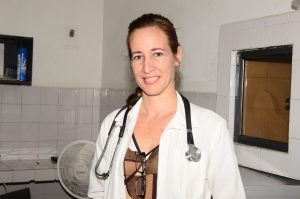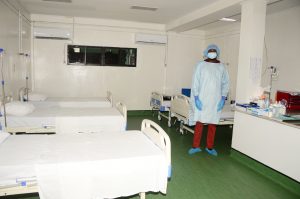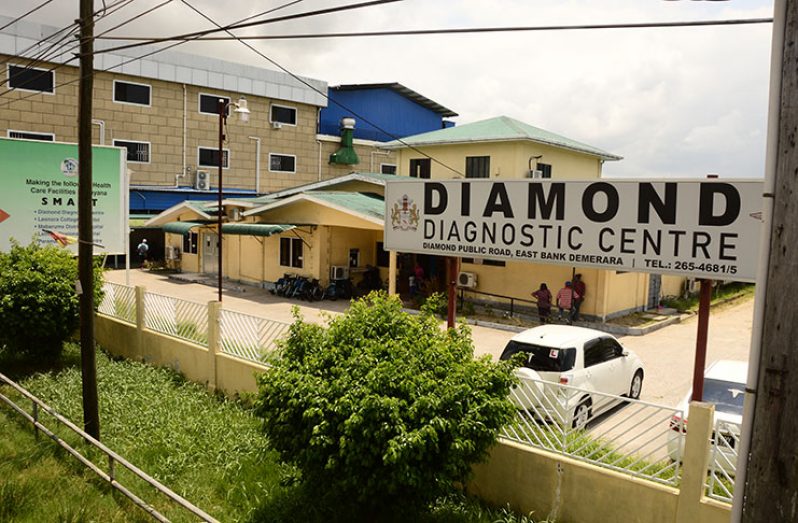By Wendella Davidson
THE Diamond Diagnostic Centre (DDC) was established in 2017 to function as a Level Three health facility, where some services, inclusive of minimum in-patient service, are being offered at the institution.

At the time of its establishment, the Diamond community which the DDC serves, along with its environs, was not as developed as it is today. Then, the daily patient roll at the hospital was 117 compared to the 400-plus that obtains today.
But as the population in that area grew exponentially to around 104,000, residents were of the perception that the centre was a hospital, hence the Ministry of Public Health is making every effort to upgrade the services being offered, says Deputy Medical Superintendent , Dr Ericka Kirton.
This, she noted, is one of the reasons behind the facility not being able to offer in-patient services, as when it was constructed, the idea was not to house inpatients. But, should a patient after being examined by a practitioner require inpatient care, that patient is then transferred to the Georgetown Public Hospital Corporation (GPHC).
In late September 2018, it was announced that the DDC is one of five health facilities to be upgraded to a “Smart” Hospital, an initiative that will see the facility being able to function optimally, particularly when faced with threats and occurrences of man-made and natural disasters.
Apart from resilience, the aim was for the facility to become one where the services are provided in such a manner that there is no cumbersomeness in terms of patients accessing the services and the staff being able to provide those services.
It was noted, that not only new doors were being opened for medicine, but that the delivery of health care in the country is being redefined through improvements in infrastructure and operational procedures.
A billboard identifying the DDC as part of the “Smart” Healthcare Initiative to provide upgraded and environmentally friendly services was subsequently unveiled.
Daily operations

The DDC has a current staff complement of 26 general medical practitioners; 11 specialists, two of whom are Guyanese and the others Cubans, an emergency medicine specialist who manages the emergency department and nurses, etc.
On a daily basis, particularly during the day shift, about five to 10 doctors are on call, handling an average of five emergencies, ranging from ectopic pregnancy, injuries as a result of vehicular accidents, gunshot wounds, attempted suicide, suicide, and severely decompensated chronic diseases such as a diabetes with kidney failure, or with a stroke.
Dr Anisa Yearwood, who works within the regional health office and also functions as the supervising medical doctor for the East Coast corridor, said that it is important for the public to understand that the GPHC is the national referral hospital of the country.
She explained, “Should patients from the different regions, let’s say suffering from the simple cough and cold, continue to flock the GPHC, then definitely the system will be overloaded, and that is what we are trying to do, to decentralise the services. Patients need to visit the health centres in their respective communities, as those facilities are well equipped with medication and can treat any illness unless it is of a serious nature. I see no need for people to join the long queues at the GPHC for the treatment of simple ailments, the common cold, diabetes, hypertension. Even if it is a patient suffering from a chronic disease, it can be treated there.” She added that at the time of visiting, a patient might be unfortunate because of an emergency coming from as far away as Region 10 (Upper Demerara-Upper Berbice) and suffering from a serious condition.
She sees the need for patient -education and awareness as it relates to certain illnesses, adding that a doctor upon examination of a patient will be able to determine if specialised attention is needed and where to send the patient to access same. And, if an illness warrants that the patient be transferred to the GPHC, that patient is prepped and stabilised first.
Range of services

Dr Kirton, meanwhile, reiterated that the services offered are wide-ranging, from treatment of chronic disease cases, such as persons suffering from high blood pressure, diabetes or any other chronic illness; dentistry, with patients being able to access cleaning, extraction and filling services; treatment for skin conditions, along with paediatricians to attend to children suffering from any kind of illness; while an OB-GYN (obstetrician-gynaecologist) is there to address women’s issues.
Dr Mark Vyphius, the medical superintendent, pointed out that under the current upgrading phase, only a few more pieces of equipment are needed, such as a non-stress test (NST) machine to which an expectant mother is hooked up, to a belt that will measure the baby’s heartbeat and movement and assess the well-being of the foetus; delivery beds and cardio monitors.

“We are looking to fully attain the capacity of doing caesarian sections. At the moment, apart from doing emergency RPOC( retain products of conception), the DDC does a few other surgeries such as the removal of fibroids, warts and the minor cases. We are upgrading the ward, so that it can soon function to its full capacity, as should a fully established maternity wing,” he added.
Other key sections at the DDC, are the emergency outpatients department, the triage area, a trauma bay that deals with (motor vehicle accidents and mass casualties, the nurses’ station and a newly established High Dependency Unit or ward with seven beds that will be used for the observation of patients who having been stabilised need to be under observation for an average of 24 hrs.
There is too an optician department , along with clinics for general surgery, dental, scheduled and emergency ultrasound, paediatrics, medical clinic, orthopaedics, Ophthalmology
According to Matron Sabrina Phillips, the DDC on a daily basis is very busy with each department having its own mechanisms. She added that one of the challenges at the facility is that there are general wards, so it is very hard to facilitate that kind of workload with an observation ward which has seven beds.
As a result, sometimes patients are dissatisfied because of the inability of the facility to facilitate inpatients, but reminded that once a patient has to be kept for prolonged management, those cases are referred to the city.
She is of the view though, that the construction of a new hospital, preferably within the Diamond housing scheme itself, would help to lessen the patient load at the DDC.




.png)









